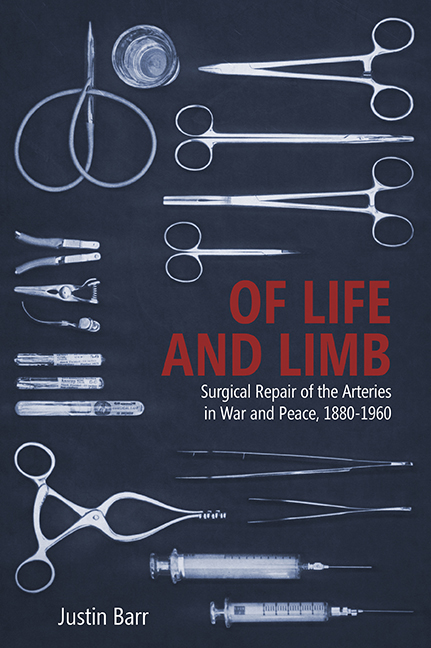 Surgical Repair of the Arteries in War and Peace, 1880–1960
Surgical Repair of the Arteries in War and Peace, 1880–1960 Published online by Cambridge University Press: 29 March 2020
“My left leg is a great deal weaker than my right,” wrote Marvin Rynar, a forty-seven-year-old watchman from Georgia to his surgeon, William Halsted. In 1906, Rynar had been struck in the thigh by a metal hoop and subsequently developed an aneurysm of the femoral artery. Halsted treated it by ligating (tying off) his left iliac artery in 1909. Rynar recovered from the surgery and in 1912 wrote Halsted to tell him how he was feeling: the aneurysm had disappeared, but “I can't walk very much as I have pains in my left leg when I do any walking … it gets very cold.” Rynar's experience exemplifies the progress surgery made in the early modern era while simultaneously demonstrating its limitations. Rynar benefitted from John Hunter's proximal ligation procedure for aneurysm, a scientifically developed operation from the eighteenth century that saved both the lives and limbs of patients who previously faced amputation or death. This clinical success and its intellectual foundation made proximal ligation a hallmark of modern surgery for the next century.
Yet Rynar also suffered for years with a painful, barely functional leg. In an effort to improve patients’ outcomes, surgeons spent the decades between 1880 and 1914 devising new operations to repair and even replace injured blood vessels. They relied on the technologies of anesthesia and asepsis, superior training, and unprecedented global collaboration made possible by journals and international conferences. In 1880, the possibility of arterial repair did not exist; by World War I, surgeons had invented a series of innovative procedures to repair arteries and successfully applied them to a few patients. However, the clinical rarity of arterial repair in the 1910s revealed a gap between invention and widespread application.
Exploring the technical development of arterial repair unpackages how procedures are created, unveiling unique elements of surgical culture. It shows how surgeons operated—both specifically in their physical manipulation of tissue and more generally in how they worked in the laboratory and clinic. While research primarily remained a solitary endeavor, the results and their impact simultaneously created and depended on a sense of authority within this community. Investigating the process of invention and dissemination reveals the priority of practical demonstration over theorizing and the crucial reliance on vivisecting animals in providing compelling evidence.
To save this book to your Kindle, first ensure [email protected] is added to your Approved Personal Document E-mail List under your Personal Document Settings on the Manage Your Content and Devices page of your Amazon account. Then enter the ‘name’ part of your Kindle email address below. Find out more about saving to your Kindle.
Note you can select to save to either the @free.kindle.com or @kindle.com variations. ‘@free.kindle.com’ emails are free but can only be saved to your device when it is connected to wi-fi. ‘@kindle.com’ emails can be delivered even when you are not connected to wi-fi, but note that service fees apply.
Find out more about the Kindle Personal Document Service.
To save content items to your account, please confirm that you agree to abide by our usage policies. If this is the first time you use this feature, you will be asked to authorise Cambridge Core to connect with your account. Find out more about saving content to Dropbox.
To save content items to your account, please confirm that you agree to abide by our usage policies. If this is the first time you use this feature, you will be asked to authorise Cambridge Core to connect with your account. Find out more about saving content to Google Drive.